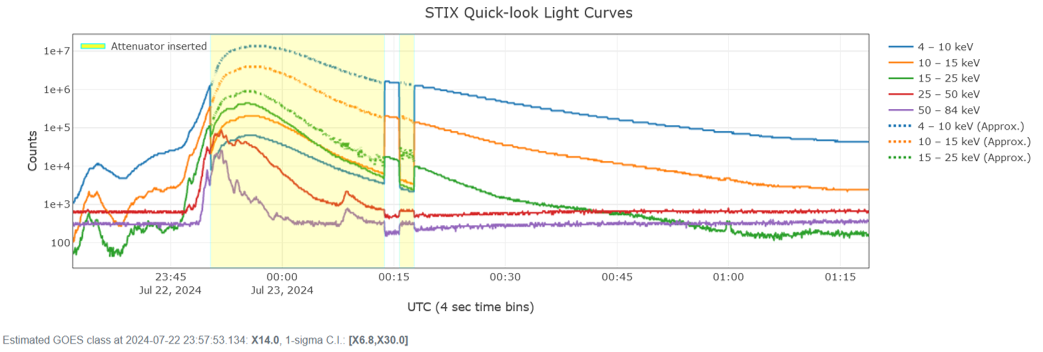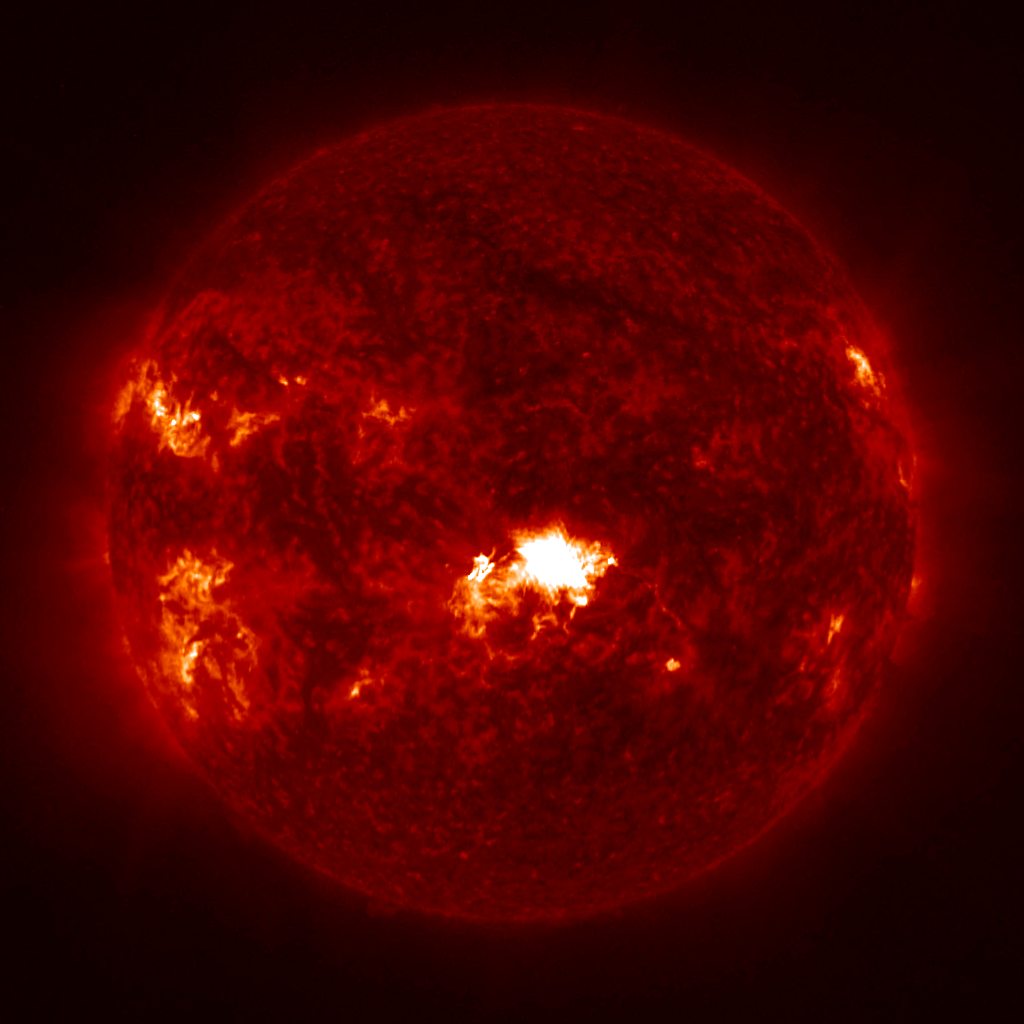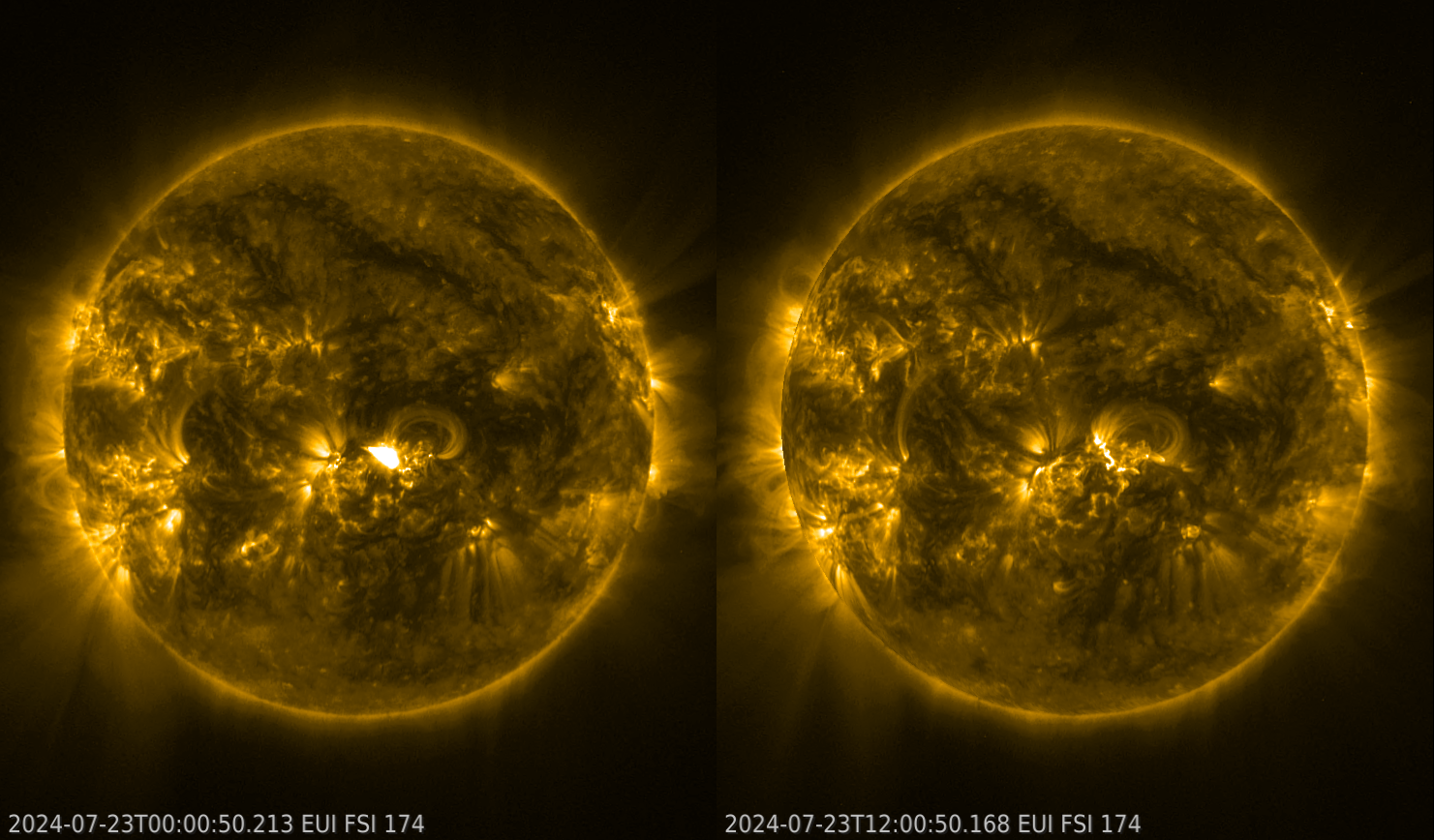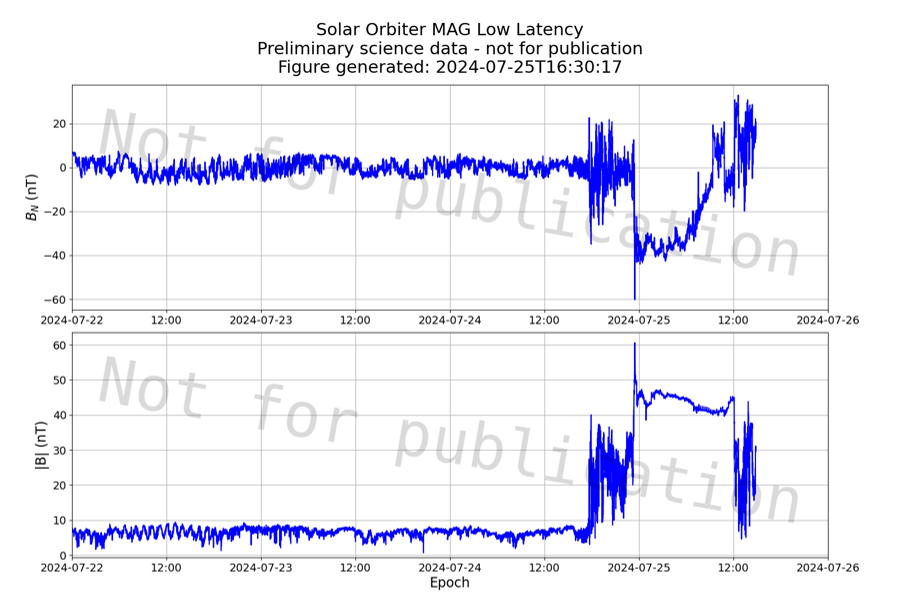Space weather forecasters were surprized to see the proton flux (GOES) going up early today 23 July, as there was no particularly strong solar flare or filament eruption observed on the Earth's facing solar hemisphere (GOES ; chart). The fluxes of the more energetic protons followed suit. The greater than 10 MeV proton flux exceeded the event threshold of 10 MeV at 03:00UTC, and is still close near its maximum of about 24 pfu. The greater than 100 MeV proton flux exceeded the 1 pfu threshold at 02:00UTC, and reached a maximum of 1.6 pfu. As a result, no effect from these particles on the Earth's surface have been observed (no Ground Level Enhancement). Updated chart with proton fluxes.

At 00:24UTC, a halo coronal mass ejection (CME) became visible in coronagraphic imagery by SOHO/LASCO C2. CACTus revealed a projected (plane-of-the-sky) speed around 600 km/s. LASCO images showed noise from the energetic protons impacting the camera's pixels (LASCO C3 clip underneath). No important radio bursts were observed around the time of this event (OVSA, Learmonth).

So, all this was indicative that the event had taken place on the farside of the Sun. But how intense was it? Once again, Solar Orbiter came to the rescue. As it happens, this spacecraft is currently observing the Sun's farside, being separated by 159 degrees from the Earth (map). Its Spectrometer Telescope for Imaging X-rays (STIX) is a hard x-ray (HXR) imaging spectrometer (see this STCE newsitem for a brief description), and recorded a strong flare on 22 July at 23:56UTC. Though STIX' HXR measurements can of course not directly be compared to the GOES' soft x-ray (SXR) recordings, given enough statistics the STIX readings can be correlated and used to provide an estimated value of the GOES SXR intensity. Thus, based on the STIX observations shown underneath (STIX data Center), the eruption reached an estimated GOES SXR intensity between X6.8 and X30, with X14 the most likely value. This is slightly stronger than the 20 May event (X12, also on the farside), and would make it the strongest solar flare so far this solar cycle (SC25), far and front side combined.

Thus remained the question of where exactly the eruption had occurred. Enter Solar Orbiter's Full Sun Imager (FSI), which is part of the EUI instrument (Extreme Ultraviolet Imager - https://www.sidc.be/EUI/intro). Only 2 images in each wavelength -30.4 nm (temperature around 80.000 degrees) and 17.4 nm (around 1 million degrees)- are available for 23 July so far, one at midnight and one at noon, but that was enough to pinpoint the location of the eruption near the Sun's disk centre as seen by Solar Orbiter. The images underneath show the Sun in extreme ultraviolet (EUV): once by FSI 304 near 00:00 UTC - which is at the time of the eruption-, and a comparison in FSI 174 at 00:00UTC and at 12:00UTC showing the evolution of the flare. Back-tracing based on the observed position reveals that the source region is NOAA 3738, which was also responsible for 2 X-class flare on 14 and 16 July (see this STCE newsitem).


From the observed direction of the halo CME (away from the Earth), it may be worthwhile to keep now also an eye on SolO's MAG instrument, as the CME is heading straight for Solar Orbiter. When the interplanetary CME passes the spacecraft -most likely tomorrow 24 July-, the Bz value observed by the MAG instrument may give an indication of the strength of the ICME. Just for reference: during the grand 10-11 May 2024 geomagnetic storm, Bz reached -50 nT (ACE/DSCOVR)...
UPDATE 25 July at 17:00UTC - The ICME arrived at Solar Orbiter around 18UTC on 24 July. This means that it took the CME about 42 hours to bridge the Sun-Solar Orbiter distance (0.9 times the average Sun-Earth distance, or about 135 million km). SolO's MAG instrument showed that after the shock and sheath passage, the core of the ICME arrived shortly before 24:00UTC. The plot below shows the evolution of the North-South component of the magnetic field ("Bz", here shown as "BN" ; top panel), and the total intensity of the magnetic field B ("Bt" , lower panel). There is a nice gradual transition from southward pointing magnetic field (negative Bz) towards northward pointing magnetic field (positive Bz). A value of -60 nT was briefly registered for Bz at the beginning of the ICME passage, but Bz was mostly between -30 nT and -40 nT during the next 6 hours. Bt remained at a very strong 45 nT throughout the entire first half of 25 July. If this ICME would have hit the earth environment, we would almost certainly have experienced an extremely severe geomagnetic storm, quite close in intensity to the recent 10-11 May storm. Please note that these MAG data are low latency data and not fully calibrated so artefacts can remain and it is not suitable for science use.

Of note is that the passage of the ICME was also recorded by SolO's EPD instrument (Energetic Particle Detector), which shows a 100-fold enhancement of the low-energy particle flux upon arrival of the ICME's shock. This is called a Energetic Storm Particles event (ESP), with another example discussed in this STCE newsitem.






